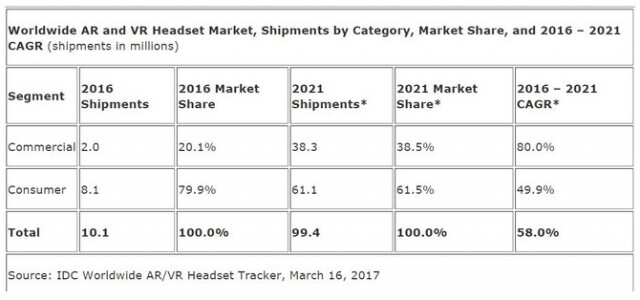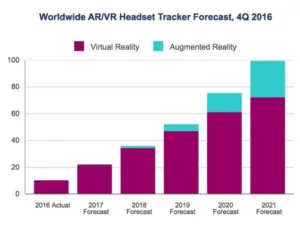When will consumers come around to face-worn display technology? According to past forecasts, that should have already happened, yet it seems that just because a display technology can be “perfected” a great display alone is not enough to ensure adoption of said technology without something else… A case in point was what happened with 3DTV displays, (enough said?) OK here’s a bit more food for thought.

The most recent marketing data to chime in, came last week with a reality-check/ forecast showing (both AR and VR) headsets down over 30% (YoY) at 1.2M units shipped in Q1-2018 from the International Data Corporation (IDC) Worldwide Quarterly Augmented and Virtual Reality Headset Tracker.
Now 1.2M units the first quarter of 2018 doesn’t seem too trivial from a nascent market, but turns out that’s being kind… considering that in 2016 IDC said 10.1M AR VR units shipped that year, and by now (2018) we should be on track to ship just under 40M units in each category for the year or about 10X what we actually saw. That historic data is based on IDC forecasts in March 2016 shown here.

2016 IDC forecast VR AV headset market data
Not wanting to repeat coverage, be sure to catch our recent story on the latest (IDC) Worldwide Quarterly Augmented and Virtual Reality Headset Tracker, by clicking the link below (subscription required)
The point here is not to pick on IDC. Getting these numbers right is hard enough, and they are the analyst’s best estimate (forecast) of what is likely to happen given current market conditions.
However, looking at the larger issue, will consumers come around to adopt a mainstream face-worn display technology? Or perhaps better asked, will adoption of VR ever move to the mainstream, or (like 3D) remain a niche technology even if it is really cool? Even at $399 I’m not going to spend my money on it. (One caveat: I am a +60 year old consumer and not exactly the target market that Oculus is going for.)
Perhaps about all that can really be said clearly about the prospect of VR taking off as a full-blown consumer technology is “we’ll see.” Will it be like 3D technology that went from media darling, star of the trade-show floor, and even (at one point) shipping with almost every top brand +65-inch diagonal large screen HDTV but which today is a technology that is relegated to a niche market where it can best serve specific application needs (medical, for instance)? The mainstream 3DTV has eventually given way to 4K, 8K and HDR displays that get pretty darn close to looking like the real thing, and that’s the whole point.
So in spite of all the investment, millions of dollars in R&D and product development in every core technology area from microdisplay light valves to fovea rendered eye tracking, all in support of augmented reality devices, we still have not crossed over into the promised land of near to eye display nirvana with a VR display devices.
Some may chalk it up to wild speculation that lead to (yes) – overblown expectations, initially driven by out of sight valuations from geeky billionaires, (ok one billionaire) with (way) too much money to spend. But even that was just a hiccup. In the display industry, perhaps the smart money is riding on the “we’ll see” crowd, but then again… Steven Sechrist
IDC: Augmented Reality and Virtual Reality Are on the Verge of Growth
VRHero Headset Has Good Optics
PeriscapeVR Launches Experience Centre at JFK Airport
Microsoft No Longer Planning to Bring VR Support to Xbox One

